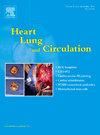Physiological Responses to Sit-to-Stand and Six-Minute Walk Tests in Heart Failure: A Randomised Trial
IF 2.2
4区 医学
Q2 CARDIAC & CARDIOVASCULAR SYSTEMS
引用次数: 0
Abstract
Background
Short-duration sit-to-stand tests are utilised in rehabilitation settings to alleviate logistical challenges associated with the six-minute walk test (6MWT). We assessed the utility of the 30-second sit-to-stand (30-STST) and 60-second sit-to-stand (60-STST) tests as surrogate measures of the 6MWT.
Method
On separate days, 16 male participants (71 [7] years) with stable heart failure with reduced ejection fraction (36.9 [4.9] %) completed two 6MWT and the 30-STST and 60-STST. Pulmonary gas exchange (oxygen consumption, carbon dioxide production [CO2], ventilation [], respiratory exchange ratio, ventilatory equivalent for CO2 [/CO2] and partial pressure of end-tidal CO2 [PETCO2]) was measured using a portable metabolic system. Non-invasive haemodynamics (cardiac output, stroke volume, arteriovenous oxygen difference) were measured using impedance cardiography. Mean arterial pressure, heart rate, oxygen saturation and dyspnoea (0–10 scale, arbitrary units) were also monitored. Mixed-effects models (Bonferroni corrected) accounting for time (pre-exercise rest, end-exercise) and test (6MWT, 30-STST, and 60-STST) were used to assess the relation between results observed during each testing modality.
Results
While PETCO2 (mean difference [95% confidence interval], −4.9 [−8.9 to −0.8] mmHg), and dyspnoea (1 [0-2] arbitrary units) differed between the 6MWT and 60-STST, no other differences were observed between these tests. In contrast, oxygen consumption (−0.5 [−0.6 to −0.3] L.min-1), CO2 (−0.5 [−0.7 to −0.4] L.min-1), (−18.3 [−26.0 to −10.0] L.min-1), PETCO2 (−5.1 [−9.6 to −0.7] mmHg), cardiac output (−2.4 [−4.9 to −0.3] L.min-1), heart rate (−20 [−33 to −7] beats/min) differed between the 6MWT and the 30-STST, however, no other differences were observed between the 6MWT and the 30-STST.
Conclusions
Cardiopulmonary, non-invasive haemodynamic and dyspnoea responses differed between the 30-STST and the 6MWT. However, the lack of test-specific differences between the 6MWT and the 60-STST highlights the strong physiological stimulus elicited by this short-duration test modality. The 60-STST has promising utility as a functional measure of heart and lung capacity within cardiac rehabilitation programs.
心衰患者对坐立和6分钟步行试验的生理反应:一项随机试验
背景:在康复环境中使用短时间的坐到站测试来缓解与六分钟步行测试(6MWT)相关的后勤挑战。我们评估了30秒坐到站立(30-STST)和60秒坐到站立(60-STST)测试作为6MWT替代测量的效用。方法:在不同的日期,16名男性参与者(71岁),稳定的心力衰竭,射血分数降低(36.9%[4.9]%)完成两次6MWT和30-STST和60-STST。利用便携式代谢系统测量肺气体交换(耗氧量、二氧化碳产生量[V˙CO2]、通气量[V˙E]、呼吸交换比、CO2通气量当量[V˙E/V˙CO2]和尾潮CO2分压[PETCO2])。使用阻抗心动图测量无创血流动力学(心输出量、搏量、动静脉氧差)。同时监测平均动脉压、心率、血氧饱和度和呼吸困难(0-10分制,任意单位)。考虑时间(运动前休息、运动结束)和测试(6MWT、30-STST和60-STST)的混合效应模型(Bonferroni校正)用于评估每种测试模式中观察到的结果之间的关系。结果:虽然PETCO2(平均差异[95%置信区间],-4.9[-8.9至-0.8]mmHg)和呼吸困难(1[0-2]任意单位)在6MWT和60-STST之间存在差异,但在这些测试之间没有观察到其他差异。相比之下,氧气消耗(-0.5[-0.6至-0.3]L.min-1)、V˙CO2(-0.5[-0.7至-0.4]L.min-1)、V˙E(-18.3[-26.0至-10.0]L.min-1)、PETCO2(-5.1[-9.6至-0.7]mmHg)、心输出量(-2.4[-4.9至-0.3]L.min-1)、心率(-20[-33至-7]次/min)在6MWT和30-STST之间存在差异,但在6MWT和30-STST之间没有观察到其他差异。结论:心肺、无创血流动力学和呼吸困难反应在30-STST和6MWT之间存在差异。然而,6MWT和60-STST之间缺乏测试特异性差异,这凸显了这种短时间测试方式引发的强烈生理刺激。在心脏康复计划中,60-STST作为心肺功能的功能测量具有很好的应用前景。
本文章由计算机程序翻译,如有差异,请以英文原文为准。
求助全文
约1分钟内获得全文
求助全文
来源期刊

Heart, Lung and Circulation
CARDIAC & CARDIOVASCULAR SYSTEMS-
CiteScore
4.50
自引率
3.80%
发文量
912
审稿时长
11.9 weeks
期刊介绍:
Heart, Lung and Circulation publishes articles integrating clinical and research activities in the fields of basic cardiovascular science, clinical cardiology and cardiac surgery, with a focus on emerging issues in cardiovascular disease. The journal promotes multidisciplinary dialogue between cardiologists, cardiothoracic surgeons, cardio-pulmonary physicians and cardiovascular scientists.
 求助内容:
求助内容: 应助结果提醒方式:
应助结果提醒方式:


